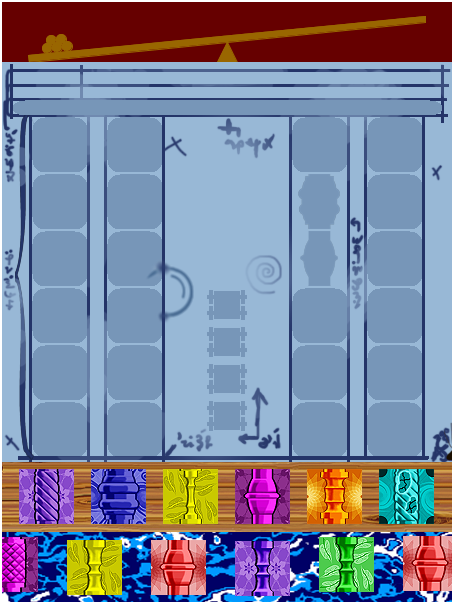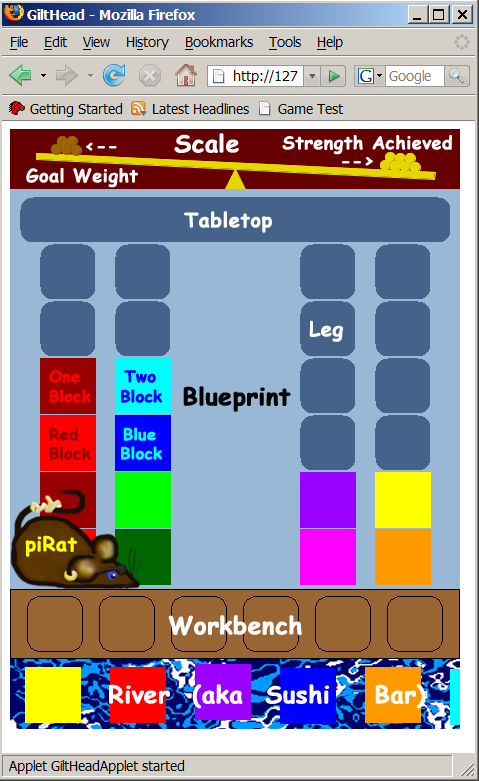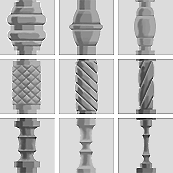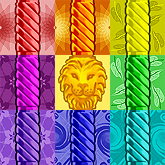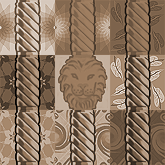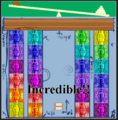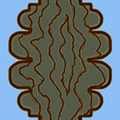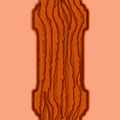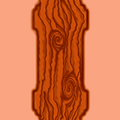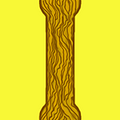GCPP:Proposal-Gilthead
Puzzle Codename: Gilthead
| Contact | |
| Username: | Perlandria |
| Additional contact info: | Irig on Viridian, Perlandria at Yahoo |
| Project forum thread: | Main forum thread |
| A prototype is available for this proposal. | |
| Check it out and contribute to the design! |
Game concept
Structural Engineering Challenge meets Occam's Quilt. (With Sushi Boats, because everything is better with sushi boats.)
Objective
Stack blocks to make table legs strong enough to bear a given weight. The more attractive the legs are (based on vertical and horizontal matching), the better.
Gameplay
Visit the prototype link for simple, cheerful directions.
Overview: Place blocks on a blueprint for a table. When the blueprint is full of blocks, the blueprint is scored and put aside. A booched blueprint is still scored and put aside. A new blueprint takes the scored blueprint's place until the specified number of blueprints shown in the scroll artwork are completed.
At the top is the Scale. In the middle is the Blueprint, which has a table top space and 4 legs made of 6 game blocks. On the Blueprint are spaces for blocks, and Scrolls for the number of blueprints in the session. There is a piRat hidden in the Blueprint. Under that, is the Workbench which has spaces for 6 game blocks. At the bottom is the sushi-boat River where blocks enter the game by floating along the River from left to right.
More detailed:
Starting from the bottom of the Blueprint and working your way up, place Blocks in each of 4 columns to build table legs that can bear the weight indicated by the Scale and the tabletop art. The 4 legs may be filled in any order horizontally, as long as each is filled from the bottom to the top. The 4 legs may be filled at any rate. ex: You may finish 1 leg but leave the other 3 empty if you want to.
You can put Blocks from the River directly on the Blueprint, or place them in your Workbench to use later. Once a Block is on your Workbench, you must move the block to the Blueprint to get it out of your Workbench. Clogging the Workbench does not stop the River or keep a Block from being placed on the Blueprint. A Block on the Blueprint can not be moved. There is no discard. This will become more important if we implement Boxes (see notes).
When your last block is placed, the top of the table is set on the legs. If the strength requirement is met, it will then be scored. If not, the table legs will 'collapse under the weight' (no art coded at this time), and you've booched. A booch is still scored as a booch. Another Blueprint will appear for you to work on next.
Ideally, at first, blueprints and shapes and colors of blocks will be limited. Scores will also be limited. As many other PP games do, doing well unlocks complexity and higher score potential. For this game, advanced levels would have the full variety of blueprints, the full shape set including knots, the full color set, the full wildcard set, and bonus target shapes in the blueprint. This advancement model is reflected in the Greenie Game and Normal Game buttons on the prototype page and in scoring displays. People who want to customize playing the prototype can access a menu of choices with the Define Custom Parameters button. The prototype does not offer the full variety of blueprints at this time, even in Define Custom Parameters, for ease of coding scoring on the back end.
(The above image is a screen shot of our in-development prototype game applet. The writing in the above image was added after the fact.)
Gameboard details:
The Scale is weighed down on the left by 5 large, dark balls. As pieces are placed on the diagram, small balls are placed on the right of the scale. The Scale moves in balance and changes hue from dark to light to show quality of progress. When the goal weight is reached, not only is the Scale at balance but the fulcrum turns gold, and the background turns green.
The Blueprint has the outlines of 4 legs. These outlines are block sized. In the prototype, 6 Blocks make each leg. Up to 3 of the empty block spaces may have an outline instead of a square, to show a possible bonus if that shape of the outline is used there. The tabletop outline is thin, medium or thick to show the goal /strength/weight.
Scroll outlines show how many more tables can be made. Finished Scrolls show how many tables have been made. Scroll brightness shows the score of each table.
The piRat is a penalty for not making a move. A move is taking a Block from the River to the Workbench, from the River to the Blueprint, or from the Workbench to the Blueprint. Moving Blocks inside the Workbench does not reset the piRat's timer. Holding a Block picked up from the River before the Block is placed on the Workbench or the Blueprint does not reset the piRat's timer. The piRat's penalty is gnawing a knothole in a block, thus changing the Pass/Booch score. After the penalty happens, the piRat timer resets to repeat the two warnings again. Without a move, the piRat keeps gnawing new pieces at regular intervals until there is nothing untouched to gnaw. Ways this penalty could be applied might be by (alone or in combination to break ties): last placed, tallest leg, strongest leg, most valuable leg, leg not protected by cedar Gilthead, single strongest block, and random. piRat will eventually cause a booch through strength attrition, and will erode the strength bonus as it progresses.
The Workbench is a holding space for Blocks that are taken from the River but not immediately placed on the Blueprint. Blocks may be moved from one space to any other open space on the Workbench. The only way to remove a Block from the Workbench is to place it on the Blueprint. The Workbench is extremely useful in different ways for planning vertical color matches and horizontal shape matches which give scoring multipliers. If the River was loaded by set, Blocks on the Workbench would affect the River - but this is not coded in the prototype. The prototype loads the River by percentage.
The River displays Blocks, which float in from the left and disappear on the right in a ongoing stream of choices. In the prototype, the River is loaded by random from percentages. The percentages are based our common and rare decisions for the color value and shape of the Blocks. Typically, there are 5 Blocks showing. 6 Blocks may show at once when 1 is just entering from the left and 1 is just exiting to the right, all of which are still available to the player. More than 6 Blocks will be possible if we implement Boxes (see Notes). When a Block is taken from the River, the remaining Blocks to the left speed up to close the gap. There is no penalty, other than the piRat, for letting Blocks disappear to the right.
Block art gives information on strength by shape and value by color. Strength is by thickness. Value is in rainbow order from red through magenta.
- There are levels of shape, so new complexity and rewards can be unlocked with advanced skill. Shapes are released in sets; the two thinnest sets, the highest strength set, and then knots and the wildcard to balance complexity with reward at all three levels. Strength is not a smooth progression as some outlines 'read' to have common values. Shapes can be matched by outline for a reduced bonus; concave, straight, or convex.
- The shapes with their (strength) are:
- Any piece with a knothole (-x where x is the strength of the shape [see below])
- thin concave (2)
- thin straight (3)
- thin convex (4)
- medium concave (4)
- medium straight (5)
- medium convex (6)
- thick concave (6)
- thick straight (7)
- thick convex (8)
- cedar gilthead (1) This is a matching wildcard. Wildcards will never have knotholes.
- iron fish (10) This is a strength wildcard. Wildcards will never have knotholes.
- There are levels of color, so new complexity and rewards can be unlocked with advanced skill. With the exception of the wildcards, colors have pairs:
- golden cedar from the wildcard piece
- metallic grey iron from the wildcard piece
- red and orange
- yellow and green
- cyan and blue
- purple and magenta.
Scoring values go through the rainbow, Red through Magenta, 1 through 8, with Cedar as 10 and Iron as 1.
The colors will be released in sets. At first, the player will have Red, Yellow, Blue, and Magenta to play with. Then Orange and Cyan would be released, and finally Green and Purple. Wildcards, being scored as shapes, are released as shapes.
2 levels of color matching are possible, more valuable perfect matches (ex. red with red), and less valuable secondary paired matches (ex. red with orange). The texture behind paired colors will be matched, though inverted, so that each piece is totally unique in greyscale, but secondary matching can still be perceived.
Scoring
Scoring has a Pass/Booch minimum score based on the value of total strength of blocks in the legs. Passing the strength requirement to allows color value to be totaled.
The base score is the color value total, to which bonuses are applied.
Bonus multipliers are based on strength above the Pass/Booch requirement, vertical color matching by individual table leg, horizontal shape matching across the four table legs, whole table sets in color and/or shape, bonus pieces used, bonus target shapes met, special pattern, and speed. Special patterns and speed are not coded at this time. The cedar gilthead, as a wild card, completes matches horizontally and/or vertically but adds little strength and fits no bonus target shapes. A cedar gilthead placed to finish a vertical color match and a horizontal shape match will allow both. The iron fish matches nothing, ruining potential matches, is very strong but has low value. Knothole blocks have a negative strength (inverse to the normal strength of the shape), but otherwise do not interfere with shape and color matching or bonus outline targets. These matching multipliers can be stacked in the usual way (you know: Vegas. Monkey. Pokeyouinthenose. Etc.) See section starting three paragraphs down.
Different blueprints are a core concept and should be kept as an idea. Tabletops may be thin, medium or thick. Legs could be 3, 4, 5 or 6 Blocks tall. Scoring assumes a medium 6 table as the default. At this time, the prototype only allows a medium 6 table for ease of testing.
To simulate Puzzle Pirate alerts and rankings, scoring has been labeled with color text as bonuses are scored, and booched to incredible labels are given on the blueprints and the session.
- Booched - Failed to meet strength goal by using too many Cedar Lions, or having too many knotholes.
- Poor - A single matched column (color) or row (shape).
- Fine - One each matched row (shape) AND column (color), or equivalent score.
- Good - Half of the columns (color) and half of the rows (shape) are matched, (for a 6 high table, 2 column (color) matches and 3 row (shape) matches) or equivalent score.
- Excellent - A full blueprint of half-matching rows and columns, (for a 6 high table, either 4 columns (color) and 3 rows (shape), or 2 columns (color) and 6 rows (shape)), or equivalent score.
- Incredible - A full blueprint of full matching, or equivalent score from Patterns.
It is possible to do well enough on a single blueprint that a 3 blueprint session of Booched, Booched and Incredible will be Incredible overall.
-- BASIC MATCHING --
Cedar Lions are still weak Wild Cards. Iron Fish are still super-strong match-breakers.
Note: The number of exclamation points (!!!!) in the announcement is indicative of the score value and relative difficulty. In the regular game, perhaps these ! levels would each have a single announcement type, but we had so much fun coming up with funky Art and Architecture references, we went ahead and gave each thing its very own label - because we can! Mwahahahahaha!
"Chic!", "Jaunty!", "Posh!", "Swanky!" : Color Matching Columns. Half Matching by background design gets half score, same announcement. (Red/Orange, Yellow/Green, etc.) "Nice Legs!!" : All 4 Columns Color Matched.
"Fancy!", "Ornate!", "Chippendale!", "Victorian!", "Baroque!", "Rococo!" : Shape Matching Rows. Half Matching by profile gets half score, same announcement. (All Convex, All Straight, etc.) "Nice Curves!!" : All 6 Rows Matched.
-- COLOR PATTERNS --
- "Fire!!" : All Warm Colors (Red/Orange/Yellow). At least two of the three used.
- "Water!!" : All Cool Colors (Cyan/Blue/Purple). At least two of the three used.
- "Elementary!!" : All Primary Paint Colors (Red/Yellow/Blue). At least two of the three used.
- "Mardi Gras!!" : All Secondary Paint Colors (Orange/Green/Purple). At least two of the three used.
- "Simple Rainbow!!" : 4 Colors in Rainbow Order*, Vertical.
- "Rainbow Flag!!!" : 6 Colors in Rainbow Order*, Horizontal.
- "Royal Rainbow!!!!" : 8 Colors in Rainbow Order*, Diagonal. No Cedar Lions.
- "Brilliant Color!!!" : All One Color.
- (Rainbow Order = Red Orange Yellow Green Cyan Blue Purple Magenta and back to Red. Start anywhere in the spectrum and go around in order without gaps.)
-- SHAPE PATTERNS --
- "Kandinskian!!" : All Convex Shapes. At least two of the three used.
- "Mondrian!!" : All Straight Shapes. At least two of the three used.
- "Gothic!!" : All Concave Shapes. At least two of the three used.
- "Simple Taper!!" : Increase OR decrease w/ >2 changes.
- "Corinthian!!!" : A perfect Taper - Strict Incremental Decrease, Thin Top.
- "Egyptian!!!" : A perfect Taper - Strict Incremental Increase, Thick Top.
- "Simple Hourglass!!" : Thin Middle, Middle Two Rows Same Shape.
- "Gibsonesque!!!" : A perfect Hourglass - Strict ABCCBA, Thin Middle.
- "Simple Billow!!" : Thick Middle, Middle Two Rows Same Shape.
- "Rubenesque!!!" : A perfect Billow - Strict ABCCBA, Thick middle.
- "Pure Form!!!" : All One Shape.
-- OTHER PATTERNS --
- "Well Stacked!!!!" : All One Shape AND One Color. No additional bonus since Brilliant Color and Pure Form multiply.
- "DaDa!!!!" : The Anti-Pattern. NO shape matching, NO color matching, NO fulfillment of other patterns, No bonus pieces.
- "Surreal!!!!" : Nothing but FISH!.
-- ANTI-BONUSES --
- "A Fair Job" : When you haven't earned any shape/color bonuses, but didn't booch.
- "Booch :(" : Table did not meet minimum strength requirement. Either you used WAY too many Cedar Lions, or more likely the piRat gnawed on too many of your pieces.
-- FINAL ANNOUNCEMENTS --
"Booched :(", "Poor", "Fine", "Good!", "Excellent!!", and "Incredible!!!" : Should be familiar ;) These represent the averaging of all the Blueprints (rounds) played. These are, of course, only estimations of how the scores would rank in the pirate world, as such evaluations in Y!PP would be based on cumulative player data we don't have access to here.
Variability
There is a cedar gilthead wildcard piece for high value and completes matching bonuses. There is a iron fish wildcard piece for high strength which ruins matching bonuses. There are knothole pieces with strength values of negative the intact piece strength values. There is an extended block set for higher levels, including greater variety in shape and color. There is an extended blueprint set with bonus target outlines for higher levels. Half matching in shape and outline for flexible scoring. Complex patterns with special scores.
End criteria
The game ends when a number of blueprints have been completed. As per PP guidelines, we are aiming for a game of 3-5 minutes. That will be determined by data gathered during testing. We estimate 3-4 Blueprints per game.
Difficulty scaling
There is an extended block set for higher levels. There is an extended blueprint set for higher levels.
Crafting type
Furnishing
Known problems
- We may have too much art. Colors and shapes can be cut.
- We may have too many colors.
- Game may be both too easy in the beginning and too hard on advanced if all the extended sets are used. Perlandria likes to think the Ultimates are up for it.
- Although the table visual matches the goal of being a puzzle and not a simulation, it may be too limited to fully represent Furnishing.
- The River may be tedious if you are waiting for just the right piece. This could be helped by a Gunnery style skill-based faster River.
Notes
- This is already a group project:
Perlandria (Irig on Viridian) is a designer and the primary contact. The other designer and artist is EmberLeo (Omauwu on Viridian). ChienDD from Viridian is the coder.
- Policy added to Code, which allows a menu to choose game parameters before playing. This will greatly aid play testing. Chien rocks! All hail the code puppy.
- Game has always been solved for handedness. One developer is dyslexic. One developer is the righty in a lefty family. Another developer is a lefty in a righty family. Eg: The weights on the right of the scale stay dark so when the scale is even it is still obvious which side is goal and which side is strength. ex: the blocks are symmetric.
- Candle timer removed from concept 4/17. See forum thread and wiki history for Candle information.
- Woodgrain removed from concept 4/18. See forum thread and wiki history for Woodgrain information.
- Colors narrowed from 10 to 8 4/23. See forum thread and wiki history for Color information.
- piRat stealing a piece is shelved 4/23, for a variety of reasons including scalability, ease of coding, ease of play, limiting art, etc.
- Boxes shelved during alpha testing of code.
- Prototype blueprint frozen at Medium 6 for ease of testing.
- Lexicon
- Base Score - Score before multipliers, comprised of Value.
- Blocks - Game pieces used to fill the Blueprint.
- Blueprint - The central area of the game with the visual individual game goal of spaces to fill with blocks, and the visual overall session goal of Blueprint Scrolls to complete.
- Bonus - Something which increases score, by adding to the base score or adding to the multipliers Ex: exceeding strength goal Ex: wildcard
- Boxes - The idea of adding multiple block single click and single space choices to the River at advanced levels. Boxes may be random, shape sets, or color sets. Not coded.
- Cedar Gilthead - A special block that works as a wildcard, a value bonus and scoring multiplier.
- Color - A trait of a block, visually reflecting how it adds to the score before multipliers. Our colors are chosen for the highest contrast possible, based on Hex RGB values.
- Final Score - Base score times bonus multipliers. May refer to blueprint or session scores.
- Game Board - The area of game play, including scale, blueprint, workbench and river.
- Goal - The weight a completed blueprint's total block strength must match or exceed to win. Not meeting the goal is a booch.
- Iron Fish - A special block that acts as a wildcard with the highest strength in the game but ruins multipliers.
- Knothole - A trait of a block, visually reflecting strength of negative previous Strength.
- Multiplier - Variability conditions that amplify the base score to be the final score. aka Bonus.
- Patterns - Special ways to fill a Blueprint that result in specific individual scores and/or have pattern based scoring bonuses.
- piRat - The visual representation of the time penalty. The piRat damages pieces by turning blocks to knothole blocks if you take too long to make a move.
- River - The area of the game board where blocks enter the game.
- Scale - The area of the game board that shows goal progress of blueprint.
- Score - The score is broken into base score, bonus multipliers, and final score.
- Scroll - A marker of needed and completed Blueprints, empty or showing score by color.
- Session - The game of a series of blueprints, ending in a score made of blueprint scores.
- Shape - A trait of a block, visually indicating strength.
- Strength - A trait of a block, representing by shape, that contributes towards the goal weight the legs can hold.
- Tabletop - The area of the game board whose art indicates the strength needed to meet the goal.
- Target Shapes - Outlines in the Blueprint that, if matched by a piece, gives a score bonus.
- Value - The Base Score variable determined by color.
- Weight - The goal expressed in a number related to strength.
- Wildcard - One of the functions of the cedar gilthead block, in that it can match the color or shape in any set to complete the match for bonuses.
- Workbench - The area of the game board where blocks may be stored for later use, both in this blueprint and in the whole session.
Images
Prototype Releases
Alpha 1 -- 5/3/2008 01:30 PDT
initial release with full functionality
Alpha 2 -- 5/3/2008 11:00 PDT
Added some documentation to the initial option selection page
changed wording from 'mouse' to 'piRat' in initial option selection
Alpha 3 -- 5/3/2008 19:40 PDT
Revamped HTML Page to add documentation
Altered Font for bonus words
Caused tabletop and final bonus word to 'stick' at end of game
Changed normal mouse delays to 13,7,5
Balance Beam background color changes when reaching par
Alpha 4 -- 5/6/2008 00:25 PDT
Added Fish piece
Cedar piece strength nerfed
River flows fast whenever it's not full
Leg height fixed to 6 pieces
'Refined' is now 'Nice Curves!'
Added quick start buttons for beginner and normal games
Added background image for Blueprint
Altered Mouse Animations: right mouse more invasive than left
Adjusted probabilities of bonus/knot/normal pieces
More options for custom selection of piece probabilities
Alpha 5 -- 5/6/2008 23:05 PDT
Recompiled for Java 1.5, hopefully allowing more people to be able to play
Bonus Outlines now in white, not black (showed up poorly against blueprint image)
Nom! text made a more visible color
Alpha 6 -- 5/20/2008 00:05 PDT
Additional bonus for all one color
Additional bonus for all one shape
Shape half-matching (any similar shape matches for half points in a row)
Pieces can now be dragged!
Fixed bizarre button behavior for custom game start
Raised scores required to achieve particular levels
Target Shapes
Rewrote score calculation code for readability and rational behavior
River speed now a run-time adjustable parameter
Text animates faster
HTML updated
Alpha 7 -- 9/15/2008 00::23 PDT
All pieces are slightly stronger
Tabletop thickness has been fixed at max thickness (par value 120)
Knotting a piece gives it _negative_ its original strength (vs 0)
New policy for PiRat eating: completely random piece
Systemic change:
We are now differentiating the _pass_ strength from the _par_strength, where a board
below the _pass_ strength will booch, but a board must have at least _par_ strength
in order to get strength bonuses.
Altered coloration of the balance beam:
Beam itself will change color at pass strength and par strength on current board
Background will change color smoothly based on the rate of increase in strength
Bugfix: target space matching should only apply if the row gets a full/half match bonus.
Alpha 8 -- 11/21/2008 00:00 PDT
Holding down Space Bar makes River flow faster
Improved Rationality of Bonus Exclamation Points
New Custom Game option: debug mode -- right clicking on piece in river
brings up menu allowing player to change identity of piece.
New Bonuses:
Two/Three color sets:
Fire: Red/Orange/Yellow
Water: Blue/Cyan/Purple
Elementary: Red/Yellow/Blue
Mardi Gras: Orange/Green/Purple
Two/Three Shape Sets:
Kandinskian: all convex shapes
Gothic: all concave shapes
Mondrian: all straight shapes
Above Perfect Shape (each row has only one shape):
Tapers -- increasing/decreasing sizes of pieces
Hourglass/Billow -- two center rows identical, increasing/decreasing size
from center.
Rainbows -- each stripe must have color/cedar:
Simple: four adjacent colors in columns
Flag: six adjacent colors in rows
Royal: eight adjacent colors in diagonal strips (no cedar allowed)
Change to Dada:
Dada only awarded if no other shape/color bonuses awarded
requires no matching shape or color in either row or column
Other images
These are images relating to this GCPP but were never included in this page.
